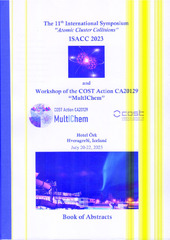Приказ основних података о документу
Quantum chemical insight into excited states of organometallic molecules
| dc.creator | Zlatar, Matija | |
| dc.date.accessioned | 2023-08-04T12:42:51Z | |
| dc.date.available | 2023-08-04T12:42:51Z | |
| dc.date.issued | 2023 | |
| dc.identifier.uri | https://cer.ihtm.bg.ac.rs/handle/123456789/6434 | |
| dc.description.abstract | In this talk, we will illustrate how different quantum chemical flavors are used in practice to deal with the excited states of organometallic and coordination compounds. We will show examples of the use of the time-dependent density functional theory (TD-DFT), ligand field DFT (LFDFT), the complete active space self-consistent field (CASSCF), and N-electron valence state perturbation theory (NEVPT2). We will address the benefits and shortcomings of these methods. | sr |
| dc.language.iso | en | sr |
| dc.publisher | MBN Research Center gGmbH | sr |
| dc.relation | info:eu-repo/grantAgreement/ScienceFundRS/Ideje/7750288/RS// | sr |
| dc.relation | info:eu-repo/grantAgreement/MESTD/inst-2020/200026/RS// | sr |
| dc.relation | COST Action CA20129 MultIChem (Multiscale Irradiation and Chemistry Driven Processes and Related Technologies) | sr |
| dc.rights | openAccess | sr |
| dc.rights.uri | https://creativecommons.org/licenses/by/4.0/ | |
| dc.source | Book of abstracts - 11th International Symposium "Atomic Cluster Collisions" (ISACC 2023) and Workshop of the COST Action CA20129 “MultIChem”, July 20-22, 2023, Hveragerði, Iceland. | sr |
| dc.subject | quantum chemistry | sr |
| dc.subject | excited states | sr |
| dc.subject | TDDFT | sr |
| dc.subject | LFDFT | sr |
| dc.subject | CASSCF | sr |
| dc.subject | coordination chemistry | sr |
| dc.subject | organometallic comopunds | sr |
| dc.title | Quantum chemical insight into excited states of organometallic molecules | sr |
| dc.type | conferenceObject | sr |
| dc.rights.license | BY | sr |
| dc.citation.spage | 45 | |
| dc.citation.epage | 45 | |
| dc.citation.rank | M32 | |
| dc.identifier.rcub | https://hdl.handle.net/21.15107/rcub_cer_6434 | |
| dc.identifier.fulltext | http://cer.ihtm.bg.ac.rs/bitstream/id/26386/ISACC2023.pdf | |
| dc.type.version | publishedVersion | sr |
Документи
Овај документ се појављује у следећим колекцијама
-
TMMagCat
Tailoring Molecular Magnets and Catalysts Based on Transition Metal Complexes -
Radovi istraživača / Researchers' publications


